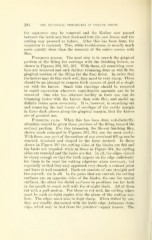Page 606 - My FlipBook
P. 606
294 THE TECHNICAL PROCEDURES IN FILLING TEETH.
the separator may be removed and the Koeber saw passed
between the teeth and then fastened into the saw frame and the
cutting may proceed as before. After this has been done, the
separator is replaced. This, while troublesome, is usually much
more quickly done than the removal of the entire excess with
files.
Finishing knives. The next step is to search the gingival
portion of the filling for overlaps with the finishing knives, as
shown in Figures 380, 381, 382. With these, all remaining over-
laps are removed and such further trimming done as will fit the
gingival portion of the filling for the final finish. In order that
the knives may do this work well, they must be very sharp. There
should be no attempt to remove thick masses of gold at a single
cut with the knives. Small thin shavings should be removed
in rapid succession wherever considerable amounts are to be
removed. One who has attained facility in their use, can do
trimming faster with the knives than with files, and model up
definite forms more accurately. It is, however, in searching out
and removing the last traces of overlaps of the cavity margin
in these dark places along the gingival margin, that the knives
are of greatest use.
Finishing files. When this has been done satisfactorily,
attention should be given those portions of the filling toward the
occlusal portion. For this trimming, the file-cut finishing files,
shown much enlarged in Figures 383, 384, are the most useful.
With these, any part of the surface of any proximal filling can be
reached, trimmed and shai^ed to the form desired. In those
shown in Figure 383 the cutting sides of the blades are flat and
the backs are rounded, while in those in Figure 384, the cutting
sides are rounded and the backs are flat. In all, the edges should
be sharp enough so that the teeth appear on the edge sufficiently
for them to be used for cutting edgewise when necessary, but
especially so that thej' may approach very closely a contact point
and leave it well rounded. Each set consists of one straight and
two curved ; six in all. In the pairs that are cun-ed, the cutting
surfaces are on opposite sides of the blades, the one for mesial
surfaces, the other for distal surfaces in positions too far back
in tlio mouth to reach well with the straight blade. All of them
cut with a jnill motion. For these to cut well, the cutting edges
must be sunk at right angles with the plane of the cutting sur-
face. The edges must also be ke]>t sharji. AVhen dulled by use,
they are readily sharpened with tlic knife edge Arkansas stone
slips, which may be had from the jewelers' supply houses. The


